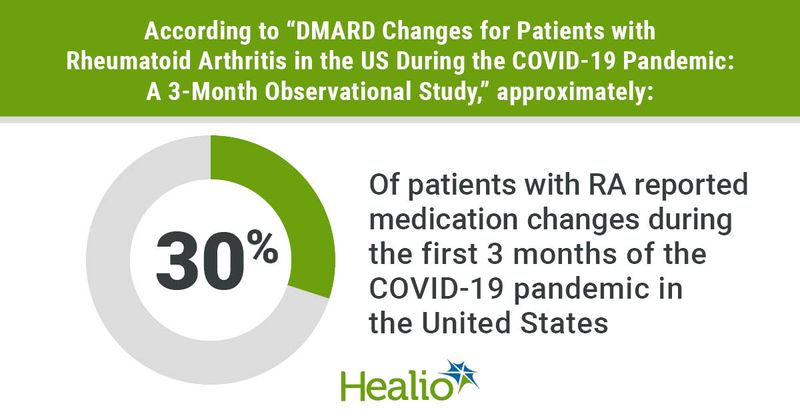COVID-19 pandemic sparked 'substantial' drug changes in patients with rheumatoid arthritis
Patients with rheumatoid arthritis in the United States made “substantial” medication changes in the first 3 months of the COVID-19 pandemic, with and without physician guidance, according to data published in Arthritis Care & Research.
“During the first few weeks of the pandemic in the United States, there was a ton of information being shared with the public about COVID-19, and much of it was later found out to be misinformation,” Kaleb Michaud, PhD, of FORWARD, The National Databank for Rheumatic Diseases, based in Wichita, Kansas, and the University of Nebraska Medical Center, told Healio Rheumatology. “Still, the process of science — the understanding, testing and discovery — was being watched in real-time.”

“Subsequently, many people with rheumatic autoimmune diseases, such as rheumatoid arthritis, were deciding what to do based on the news rather than discussions with their rheumatologist or doctors,” he added. “Many physician appointments were canceled, and most physicians didn’t know what the best course of action was. Hence, the first recommendations from the American College of Rheumatology, on April 13, 2020, was such an important first step medication treatment and changes.”
To analyze changes in medication, lifestyle and clinical care among patients with RA during the first 3 months of the COVID-19 pandemic in the United States, Michaud and colleagues studied data from the FORWARD observational registry. In addition to their regular semiannual questionnaires, participants in the registry were invited via email between March 25, 2020, and June 2, 2020, to complete up to five supplemental COVID-19 questionnaires.

For their own study, Michaud and colleagues focused on adult patients with RA who completed at least one semiannual questionnaire between January 2018 and January 2020 and at least one COVID-19 questionnaire administered in May 2020 and June of 2020. They also limited their inclusion criteria to patients receiving either hydroxychloroquine, another conventional synthetic disease-modifying antirheumatic drug, a TNF-inhibitor biologic DMARD, a non-TNF-inhibitor biologic DMARD, a JAK inhibitor, NSAIDs, or glucocorticoids.
In all, Michaud and colleagues included 734 patients in their analysis. They compared medication changes based on DMARD exposure using logistic models, adjusting for age, sex, comorbidities, education, health insurance, RA activity, fatigue and polysymptomatic distress.
According to the researchers, 30.1% of the included patients reported medication changes. Among those who altered their medication, 33% used glucocorticoids prior to the COVID-19 pandemic, compared to 18% of those who remained with their treatment. Meanwhile, those who changed medications were less likely to use non‐hydroxychloroquine conventional DMARDs pre-COVID-19 — 49% compared with 62% among those who stayed with the same treatment. Patients who changed medication reported more economic hardship during the pandemic — 23% compared with 15%.
Although JAK inhibitor use was associated with treatment change (OR = 1.9; 95% CI, 1-3.4), only pre‐pandemic glucocorticoid use remained a strong predictor (OR = 3; 95% CI, 1.9-4.9) in multivariable models. Meanwhile, changes in care were significantly associated with pulmonary disease (OR = 2.9; 95% CI, 1.3-6.5), worse RA activity (OR = 1.1; 95% CI, 1-1.1) and glucocorticoid use (OR = 1.6; 95% CI, 1-2.5).
The overall incidence of treatment change was the same before and after the publication of the ACR guidelines. However, self‐imposed changes were approximately twice as likely before their publication, while physician guided changes were more likely after.
“We showed quantitatively that the situation I described above, mostly discussed in news articles and editorials, was fairly correct,” Michaud said. “We also showed that comorbid lung conditions and use of glucocorticoids were the most important factors associated with changing DMARD medications, likely due to early reports of risks for infection and complications. We had previously reported issues related to obtaining HCQ access in March 2020 for some of our participants.”
“It was also interesting to see how behavior changed regarding DMARDs that would soon be tested in randomized clinical trials for treating more advanced COVID-19,” he added. “Even with some being approved now to treat both RA and COVID-19, it will be interesting to see the uptake or changes, if any, for these DMARDs. Recommendations in a time of confusion and misinformation can be extremely helpful to our patients and our providers, and this provides an example of that dissemination in effect.”

